Tables are important ways to represent data so that users can read it easily. Who would have thought that InDesign, a desktop publishing software, can create tables? Tables are great in publishing since they fit data that you need your readers to find. These could be information, graphs, statistics, infomercials, etc. For these reasons, it is important to know how to create Tables in InDesign.
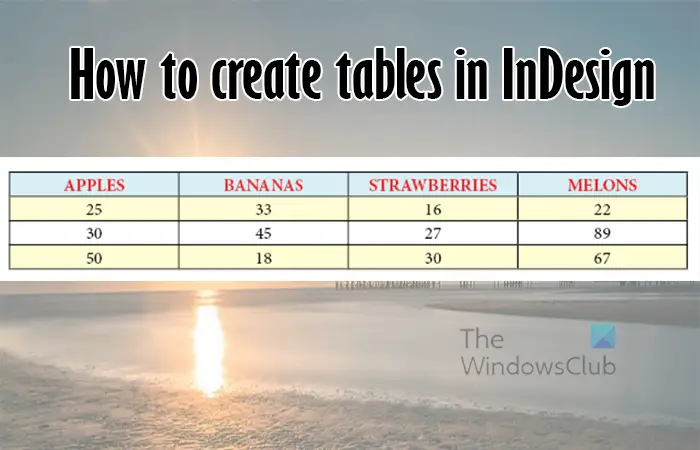
How to create a Table in InDesign
There are three ways to create tables in InDesign, you can convert text to a table, use the Insert table function or import a table from Excel into InDesign. This article will show you how to create tables in InDesign using these methods.
- Convert text to table
- Insert table
- Import table from Excel
1] Convert text to table
The convert text to table function In InDesign is very important as it allows you to write text or copy texts from Word or other word processing software and convert them into a table.
Write text in InDesign
You can convert text written in InDesign to a table in simple steps. Click the Type tool then click and drag to create a text frame. You would then write the text, you would press the tab key after each word for the headings/first line.
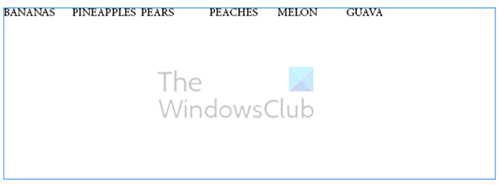
You can press tab once or as many times to create space between each word. You can just press tab once, some words will be closer to each other based on the length of the text. This will not be a problem when the conversion is made.
For the second row of the table, press enter after the first set of text, follow the same write then tab rule as in the first line. Use the same amount of tab press as you used in the first line. Using the same amount of tab presses will ensure that each content falls under each other when the table is created. If you want each text to fall under each other, make the lines of text corresponding number to what is above.
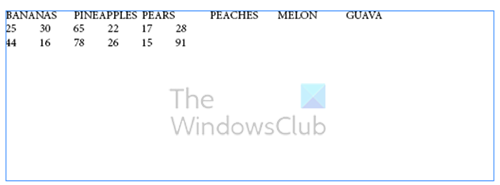
To write the next row that would fall under the headings just press enter and write the first word or number then press tab. Press tab the same amount of times that you pressed for the first line. If you press tab once between each word in the first line then press tab once in the second and other lines that follow.
When you place the text in InDesign, do not worry about how jumbled it looks. The tab was pressed once between each text and Enter was pressed once between each line. The next step will take care of that. Note that you may have to do formatting, however, everything should be lined up perfectly.
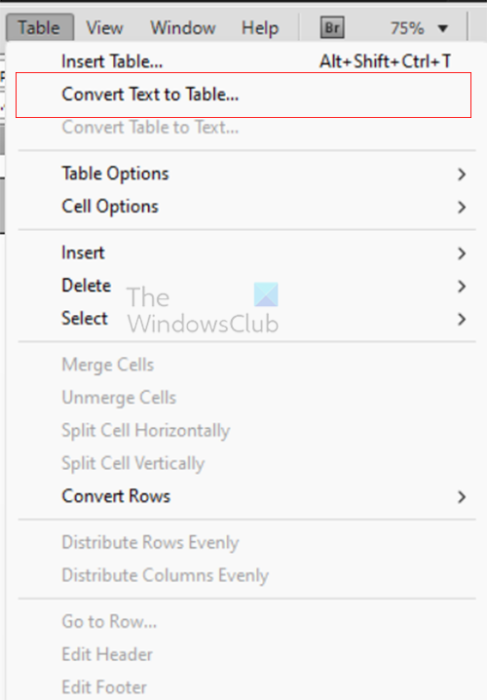
To create the table from the text, select all the text then go to the top menu and press Table then Convert text to table.
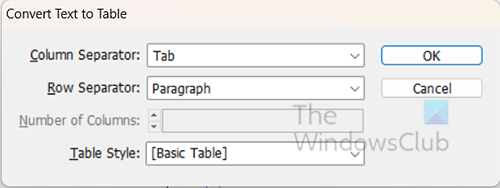
The Convert text to table window will appear. You can leave the Column Separator at Tab and the Row Separator at Paragraph then press OK. Tab means that the text will be separated into columns based on where the tabs are. The Paragraph option means that the text will be separated into rows based on where the paragraph starts.
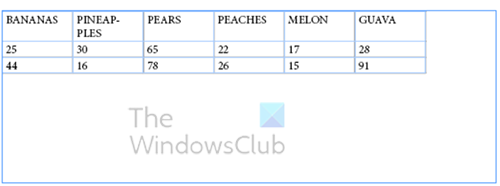
This is the text properly formatted into a table.
Copy text from Word or other software
BANANAS, ORANGES, PINEAPPLE, MELON
24, 17, 54, 13
17, 84, 15, 9
You can create tables in InDesign by copying text from Word or other software. To make the table come out with correct columns and rows, place a comma after each text that you want to fall in a column. See how the texts are written above.

You then copy and paste the text into InDesign, select all the text, go to the top menu bar and select Table then Convert text to table.
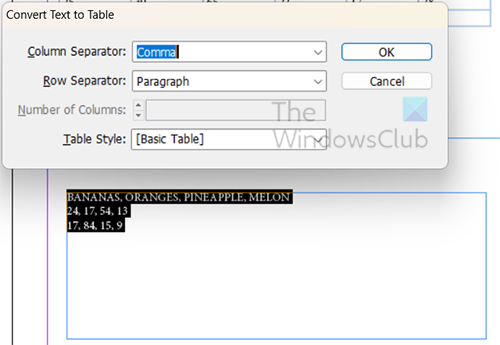
The Convert text to table window will appear, and you will change the Column separator to Comma and the Row Separator to Paragraph.
2] Insert table
The second way that you can create tables in InDesign is to insert them.
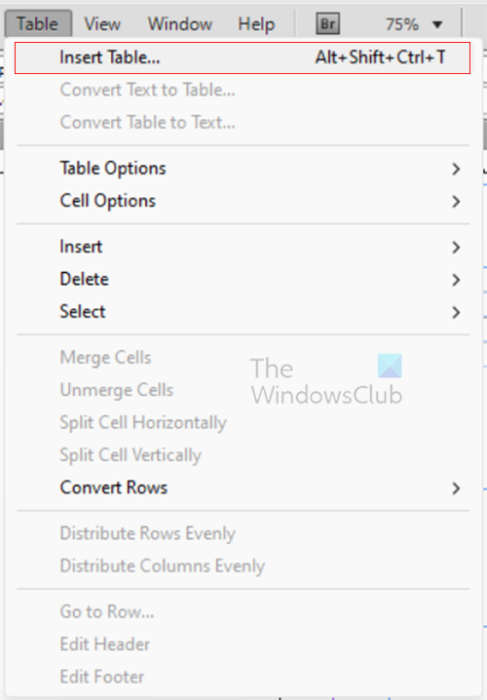
To insert the table, select the Type tool then click and drag to create a text frame. When the text frame is created go to the top menu and click Table then Insert table or press Alt + Shift + Ctrl + T.
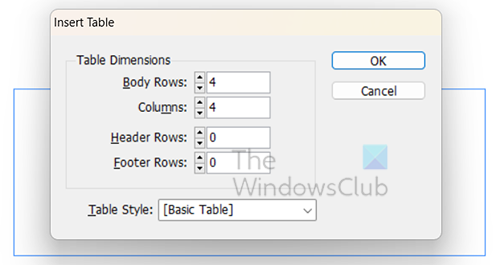
The Insert table window will appear, choose the number of rows and columns that you want for your table then press Ok.
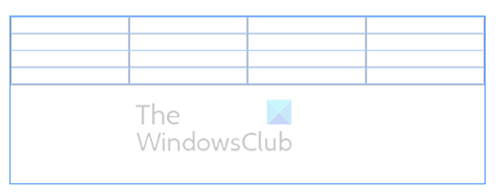
This is the table with four columns and 4 rows as chosen in the Insert table options.

You can add your data and format the table as you want.

You can format the table with text colors and row colors.
3] Import table from Excel
You may have a table in Excel and you want to add it to your desktop publication in InDesign. No need to worry, you can take your table from Excel and place it in InDesign. When you take your table from Excel and place it in InDesign, you get the formatting from Excel. You can then tweak the table to get it to fit your InDesign project.
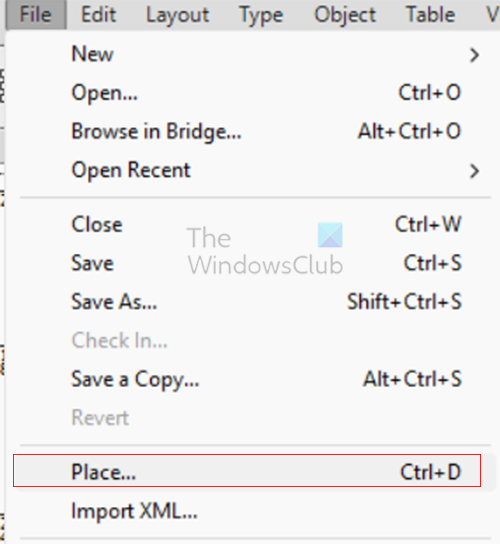
To place your Excel table into InDesign go to the top menu bar in InDesign and click File then Place or press Ctrl + D.

If the table comes across and is not fully formatted like it is in Excel, just select all the text then go to Table then Convert Text to table. Set the Column Separator to Tabs and the Row Separator to Paragraphs. If you have merged and centered cells, you can do the same in InDesign. To merge and center select the cells that you want to merge then right-click them then select Merge Cells. When the cells are merged, you can then center the content.
Read: How to create interactive PDF in InDesign
How do I add a blank column to a table in InDesign?
If you need extra columns in your table in InDesign it is quite easy to add them. Select the column that you want to be after the new column or columns that you will create. Right-click the selected column and from the menu click Insert then click Column. The Insert Column(s) window will appear. Select the number of columns that you want then select Left or Right to choose where you want them to go in relation to the selected column, you then press Ok.
How do I apply styles to a table in InDesign?
Tables in InDesign can look just as attractive and functional as tables in other software. You can add styles to your table to make it stand out and the data easy to read. To add styles and other formatting, select the table then go to Table then Table Options then Table Setup. You can also just select the table and then press Alt + Shift + Ctrl + B. The Table options window will appear, here you can choose how you want your table to appear.
Leave a Reply